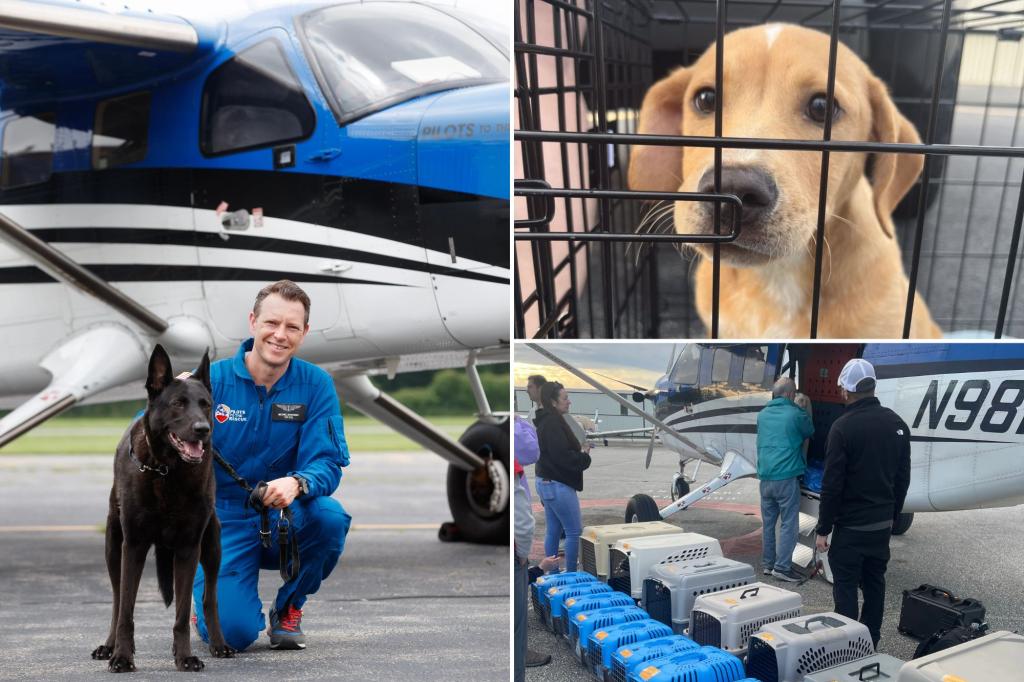New York native Michael Schneider’s passion for rescuing animals came at a young age — when he was just 6 years old.
And he’s been flying high about it ever since.
“That’s all I ever knew growing up,” he told The Post, remembering how his family would go to the local SPCA, a no-kill shelter, in Briarcliff Manor in Westchester County and bring home dogs and cats.
“Beyond that, I used to take in animals from the neighborhood. I was the little boy that took in the injured bird with a broken wing and nursed it back to health,” he reminisced. “I even had a pet sitting business when I was 11 years old.”
Later, after discovering a passion for flying following a skydiving trip, he chose to become a commercial pilot — and then combined his two loves.
In 2015, he founded the airborne angels group Pilots to the Rescue, a transportation nonprofit that saves at-risk animals in need of relocation and shuttles them from overcrowded and under-resourced shelters to partner rescues where they can be in a safer environment.
To date, Schneider and his team have flown a whirlwind 353,600-plus miles on 313 missions that saved 4,488 animals from North Carolina to Florida to Texas.
“I wanted to do something of substance with this pilot’s license that I worked so hard to achieve,” the 48-year-old Brooklyn resident said. “I heard about people transporting animals at risk of being euthanized using airplanes, so when I learned about that, of course, I jumped on that opportunity.”
In less than 48 hours after coming up with the idea, Schneider raised $12,000 from friends and family to support his two passions, “letting them know that our furry friends don’t have a voice.”
“They would say, ‘Well, why an aircraft?’ And I would tell them that the faster we can get them out, the faster we can save them — which, literally, sometimes these animals have less than 24 hours to get out,” he added.
The transports are more of a hybrid situation. Schneider said of the “novel” concept that most of the work is done on the ground with sprinter vans that drive through the night with the animals before boarding a plane in the morning. This method allows them to cover more ground and save costs.
Schneider said the whole process is easier on the animals, too.
“When they get to the other side, they might feel a little timid coming out of the crate, but when we get them out, their tails are wagging, they’re jumping up and down, they feel energy,” Schneider said.
“Animals are smarter than we give them credit for,” he added. “People are waiting for them to receive them, so they pick up on that. It’s beautiful to see.”
Pilots to the Rescue — which flies its plane out of a hangar in Essex County, New Jersey, and is one of about 10 organizations in total that rescue animals with planes in the US — has existing relationships with individual shelters and also works with large organizations such as Humane World for Animals, formerly the Humane Society of US, to coordinate efforts with shelters.
Sometimes, smaller shelters don’t have enough animals for a full rescue mission, so they’ll make it a “multi-shelter effort.”
On a recent transfer with St. Francis Animal Shelter in Georgetown, South Carolina, the shelter coordinated with other local facilities in “desperate need of help” and “bursting at the seams” to let them know that there was space on the plane for more adoptable animals to clear out the shelters.
“At-risk” mainly means that animals may face euthanasia, but it could also be a medical case — especially with veterinarian costs skyrocketing, which can be a strain on both shelters and pet owners.
The team also does missions with wildlife and endangered species, such as sea turtles, wolves and critically endangered red bulls, also known as banteng.
“The endangered species work is really rewarding,” Schneider told The Post. “Of course, we want to save them all, but sometimes when you’re rescuing all these dogs and cats, you feel like you’re chasing your tail a little bit,” he added — no pun intended.
Schneider — who lives in Greenpoint with his wife and four sons, aged 9 and under — admitted that running a charity can be a challenge, especially when needing to put food on the table. But it’s worth it to save animals’ lives — and to get feedback from adopters.
Schneider noted that some will reach out to say the rescues are the “best animals” they’ve ever taken in.
“That’s what keeps me going. To see the animals and their precarious situations that they come from — whether it be hoarding, abuse, neglect, basically left to die,” he said. “We become a voice for these animals who can’t otherwise speak.”
And even though Schneider has been passionate about taking care of animals since he was a kid, this venture helped him grow as a person even more, he told The Post.
“I used to be very narcissistic and selfish, and all about ‘me, me, me,’” he admitted. “But I started to realize that it’s more rewarding to give back, and it’s not about me anymore.”
“We want to contribute, we want to make a difference — and that’s a different type of currency.”
Read the full article here

